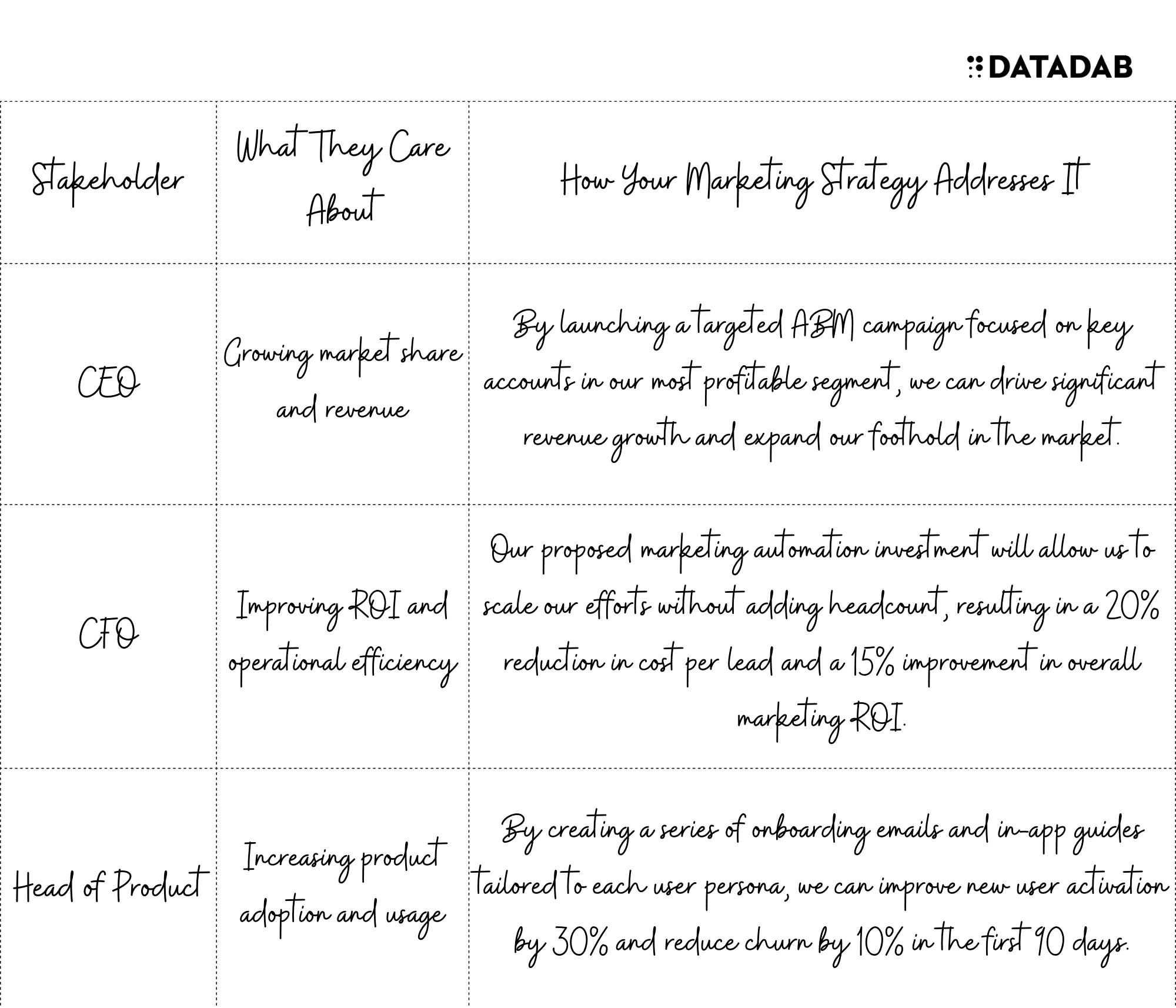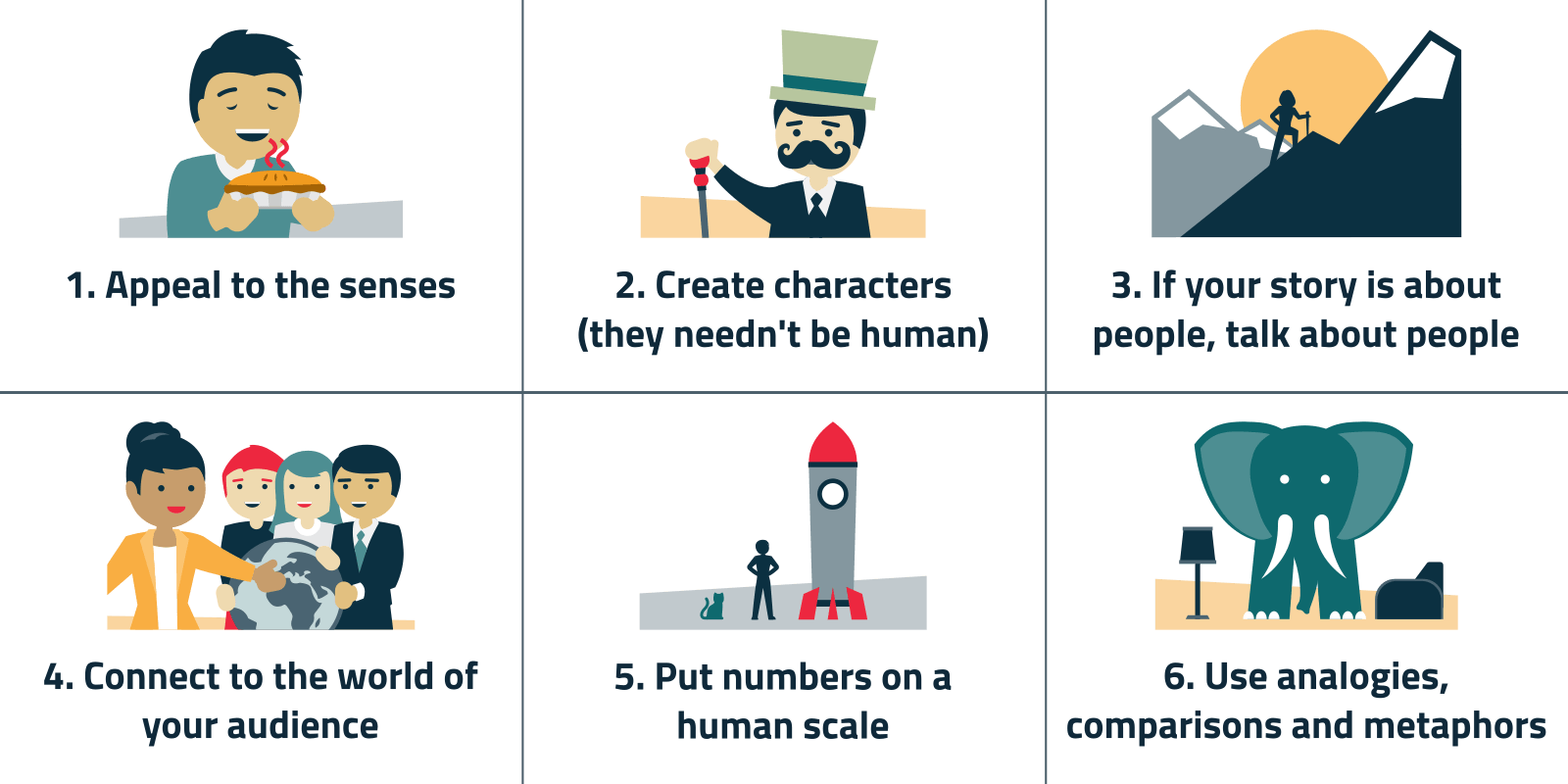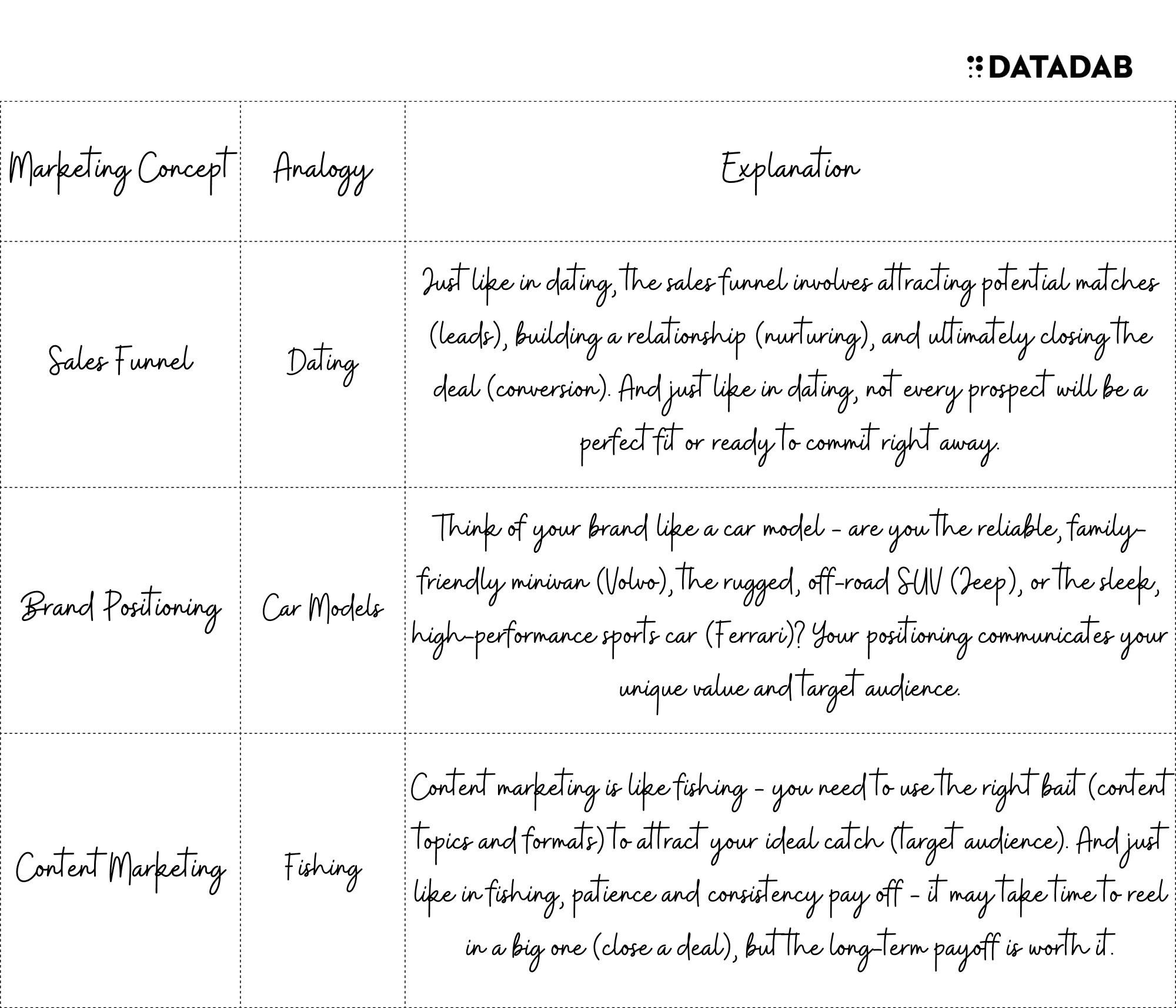I don't know about you, but I've sat through my fair share of snooze-worthy marketing presentations. You know the ones - endless slides crammed with teeny-tiny text, monotone narration that could put a caffeinated squirrel to sleep, and a “strategy” that sounds suspiciously like throwing spaghetti at the wall to see what sticks.

But here's the thing - it doesn't have to be this way! Over my years as a marketing leader and agency owner, I've discovered that the key to captivating any audience (even the big, bad C-suite) is storytelling. And not just any halfhearted attempt at a narrative - I'm talking about crafting emotionally resonant, data-driven stories that pack a real punch. The kind that make people lean in, nod their heads, and maybe even crack a smile (gasp!).

Start with the “Why” (But Not How You Think)
You've probably heard the advice to “start with why.” It's ubiquitous for a reason - launching into your marketing plan without connecting it to the bigger company priorities is a great way to lose your audience. However, most marketers take this to mean a cursory bullet on “aligning with company objectives.” Rookie mistake.

What you actually need to do is craft a vivid story around the “why” behind your plan. I'm talking about painting an emotionally resonant picture of the future state your marketing efforts will create. Some questions to consider:
- How will hitting your marketing goals tangibly change the day-to-day reality of the leadership team and the company as a whole?
- What customer or market insight inspired your strategy, and how does it tap into a larger trend that leadership cares about?
- What's at stake if the company fails to take action on this opportunity? What does the “doom scenario” look like?
For example, when pitching an ABM campaign focused on expanding into a new vertical, I once opened with a story about shadowing a sales rep on a ride-along. I described the enthusiasm and energy in the prospect's office, the “aha moment” when we realized how urgently they needed a solution like ours, and the celebratory phone call with the rep's manager after booking the meeting. Instantly, the leadership team was leaning forward in their chairs, bought into the potential of this untapped market.
The key is to make it human, visual, and high-stakes. Skip the generic “this will increase pipeline” and make them feel the urgency on a visceral level. Salesforce's State of Marketing Report found that high-performing marketers are 1.5x more likely to craft emotionally engaging stories - there's real ROI here.

Build the Story with Data
| Marketing Channel | Contribution to Pipeline | Cost per Opportunity |
|---|---|---|
| Organic Search | 40% | $500 |
| Paid Social | 30% | $800 |
| Events | 20% | $1,500 |
| Email Marketing | 10% | $200 |
Once you've hooked your audience with the “why,” it's time to reel them in with cold, hard evidence. But please, for the love of metrics, DO NOT throw up a wall of text and numbers. A dense, unstructured data dump is a guaranteed eyes-glaze-over moment.
Instead, take your audience on a clear, logical journey through the data. Some tips:
- Provide context before diving into numbers. What question are you trying to answer with this data? How does it relate to the “why” story you told upfront?
- Streamline ruthlessly and prioritize the metrics leadership actually cares about. If you can't articulate how a data point ladders up to a business goal, cut it.
- Anchor data in real-world examples. Don't say “Our NPS improved by 10 points” - say “A 10-point NPS boost means 500 more customers like Acme Co are likely to recommend us this quarter.”
- Visualize wherever possible - a simple chart or graph is often clearer than paragraphs of explanation. Just don't go overboard with the clip art.
To illustrate, here's a real example of how I used data storytelling to secure additional budget for a product launch:
| Metric | Before Campaign | After Campaign |
|---|---|---|
| Qualified leads | 500/mo | 950/mo |
| Lead-to-opp conversion | 5% | 12% |
| New pipeline | $250K | $1.1M |
| Closed-won revenue | $50K | $250K |
Clearly this campaign moved the needle, right? Not so fast. I didn't just flash this table and call it a day. Here's how I narrated it:
“Going into this launch, we knew expansion revenue would be critical to hit our targets, so we tripled down on product education and use case content. That led to a 90% jump in qualified leads, largely driven by prospects requesting demos after engaging with this content.
But the real magic happened post-demo. Our pre-launch nurture journeys and sales enablement packages helped reps better qualify and convert these educated leads. The result was a 140% increase in lead-to-opp conversion within just one quarter. That's the power of deeply understanding our target personas and orienting the entire funnel around their needs.
Not only did this generate over a million in new pipeline, but we actually closed an additional $200K in revenue within Q1 alone. Based on our historical win rates, we're confident this will yield well over $500K in expansion revenue for the year - all with only a $75K program investment.”
See the difference? Data grounded in story is far more impactful than data alone. By walking through the numbers as a logical narrative with concrete examples, you create a coherent through-line that leadership can grasp and get behind.

Bust Out the Analogies

Analogies and metaphors are powerful tools for making complex or abstract ideas more tangible and relatable. This is especially true when trying to convey the value of marketing investments to leaders who may not live and breathe campaign metrics day-to-day.
Some analogies I've found effective:
- Describing a multitouch attribution model as a “relay race” where each touchpoint plays a critical role in getting the lead across the finish line
- Framing a website redesign as “remodeling our digital storefront” to be more intuitive and appealing to visitors
- Positioning a big rock content investment as “stocking the pond” with thought leadership bait to attract target accounts
The key to a good marketing analogy is that it taps into a familiar concept the audience already understands on a deeper level. Avoid analogies that are too cutesy or forced - you want to clarify the concept, not trivialize it.
One powerful storytelling tactic is to bring the analogy to life with a personal anecdote. For instance, when advocating for a bigger events budget, I once shared the story of how I almost missed a flight due to an airline's confusing online check-in process. I described the mounting stress as each click led me down a new rabbit hole. The sinking dread as the minutes ticked closer to takeoff, and the wave of relief when I finally printed my boarding pass with seconds to spare.
“That's the experience we're currently putting event prospects through,” I explained. “We're making them jump through hoops and navigate obstacles just to learn about our brand. Imagine if instead, we rolled out the red carpet and made it effortless for them to engage - how many more would gladly walk through our doors?”
Instantly, the problem (and the upside of fixing it) became crystal clear. The budget request was approved on the spot.

Flip the Script on Objections
| Common Objection | Reframe |
|---|---|
| "We don't have budget for that." | "By reallocating just 10% of our existing budget, we can run a pilot program and gather data to build a case for further investment." |
| "Our customers aren't on social media." | "Actually, recent research shows that 60% of our target buyers use LinkedIn for business purposes. By not engaging them there, we're missing out on valuable touchpoints." |
| "We tried that before and it didn't work." | "You're right, our past attempts at this tactic fell short. But we've identified some key learnings and best practices that we believe will make a big difference this time around." |
Tactical marketing conversations have a way of devolving into opinion-slinging contests:
“I don't think this campaign will convert.”
“That messaging doesn't resonate with me.”
“I heard this channel is dead.”
As tempting as it is to get defensive or fire back with your own hot take, there's a better way. When met with marketing skepticism, flip the script by validating the concern and then reframing it as an opportunity.
For example:
“You're absolutely right, webinars can be hit-or-miss in terms of driving qualified leads. That's why we're taking a different approach with this series - by featuring a variety of customer stories and use cases, we'll attract prospects with demonstrated intent to learn how others are solving the problems they face. We'll also be layering in polling and Q&A to better qualify attendees in real-time. Our goal is to turn webinar 'tourists' into hand-raisers we can seamlessly route to sales.”
See what I did there? The skeptic's objection is not only acknowledged, but woven into the story of how this particular effort will be different. By proactively addressing potential concerns through the lens of your strategy, you can transform doubters into advocates.
I once had a CMO pushback on a proposal to expand our paid social budget, insisting that “no one scrolls Facebook hoping to hear from B2B brands.” Rather than getting confrontational, I replied:
“I completely agree that most social media users aren't in an active buying mindset. However, the data shows a significant portion of our target audience does spend time on these platforms for professional development and peer networking. By positioning ourselves as a helpful resource in those contexts - for example, through sponsored posts in relevant industry groups - we can shape their perceptions and make our brand more top-of-mind for future decisions. We've already seen this start to pay off with a 20% boost in branded organic search among key accounts.”
That CMO is now one of our most vocal advocates for social selling. All it took was a little storyselling.
Putting It All Together
At the end of the day, captivating an audience through storytelling is about creating an emotional connection, building trust, and conveying a clear vision. It's about meeting your audience where they are, and then taking them on a journey to where you need them to be.
As you craft your own marketing stories, remember:
- Anchor your narrative in the “why” - the human stakes and vision behind your plan
- Use data to illustrate your points, not overwhelm with numbers
- Employ analogies to make abstract concepts more concrete and relatable
- Proactively flip objections into opportunities that showcase your strategic thinking
Above all, keep practicing and refining your storytelling skills. The ability to communicate ideas in a way that moves hearts and minds is the hallmark of a truly great marketing leader.
Now if you'll excuse me, I have to go weave a story about how our client's latest brand campaign will make their SDRs feel like rock stars. Wish me luck!
FAQ
1. Why is storytelling important for marketing leaders?
Storytelling helps marketing leaders communicate complex ideas, inspire action, and create emotional connections with their audience. It's a powerful tool for driving buy-in, alignment, and results.
2. How can I find the right stories to tell?
Look for stories that demonstrate your brand's unique value, showcase customer success, and tap into larger industry trends. Focus on stories that are authentic, specific, and emotionally engaging.
3. How do I use data to enhance my stories?
Use data selectively to highlight key metrics, provide context, and support your main points. Present data in a clear, concise, and visually engaging way that enhances your narrative.
4. What's the basic structure of a compelling story?
A compelling story typically includes a hook, context, conflict, resolution, and lesson. Follow this arc to create narratives that are easy to follow and strategically persuasive.
5. How can I make my stories more relatable?
Use analogies and metaphors to compare unfamiliar ideas to something your audience already understands. Choose comparisons that are relevant and meaningful to your specific audience.
6. How do I handle objections when telling stories?
Anticipate potential objections and address them proactively in your narrative. Acknowledge concerns head-on, then reframe them as opportunities or challenges your marketing efforts can solve.
7. How can I use storytelling to motivate my team?
Share stories that highlight the human impact of your work, create a sense of shared history and culture, and celebrate your team's successes. Be authentic and create opportunities for team members to share their own stories.
8. How do I adapt my stories for different audiences?
Tailor your language, tone, and focus to the needs and preferences of each audience. Consider the background knowledge and communication styles of your listeners and adjust accordingly.
9. How do I measure the impact of my stories?
Track metrics like audience engagement, lead generation, brand perception, and employee engagement. Assign a monetary value to these metrics to calculate the ROI of your storytelling efforts.
10. How can I continuously strengthen my storytelling skills?
Seek feedback, study great storytellers, experiment with different formats, practice regularly, and stay curious. Continuously refine your techniques and learn from your successes and failures.






